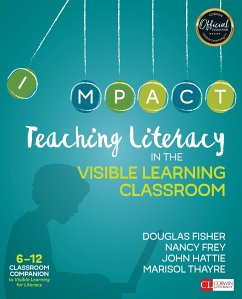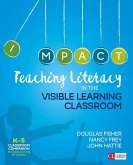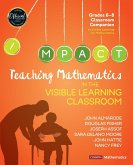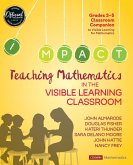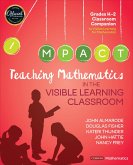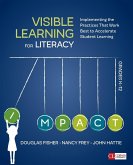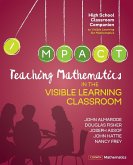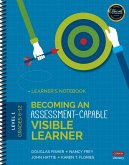Douglas Fisher, Nancy Frey, John Hattie
Teaching Literacy in the Visible Learning Classroom, Grades 6-12
Douglas Fisher, Nancy Frey, John Hattie
Teaching Literacy in the Visible Learning Classroom, Grades 6-12
- Broschiertes Buch
- Merkliste
- Auf die Merkliste
- Bewerten Bewerten
- Teilen
- Produkt teilen
- Produkterinnerung
- Produkterinnerung
This companion to Visible Learning for Literacy shows you how to use learning intentions, success criteria, formative assessment and feedback to achieve profound instructional clarity.
Andere Kunden interessierten sich auch für
![Teaching Literacy in the Visible Learning Classroom, Grades K-5 Teaching Literacy in the Visible Learning Classroom, Grades K-5]() Douglas FisherTeaching Literacy in the Visible Learning Classroom, Grades K-542,99 €
Douglas FisherTeaching Literacy in the Visible Learning Classroom, Grades K-542,99 €![Teaching Mathematics in the Visible Learning Classroom, Grades 6-8 Teaching Mathematics in the Visible Learning Classroom, Grades 6-8]() John T. AlmarodeTeaching Mathematics in the Visible Learning Classroom, Grades 6-842,99 €
John T. AlmarodeTeaching Mathematics in the Visible Learning Classroom, Grades 6-842,99 €![Teaching Mathematics in the Visible Learning Classroom, Grades 3-5 Teaching Mathematics in the Visible Learning Classroom, Grades 3-5]() John T. Almarode (USA James Madison University)Teaching Mathematics in the Visible Learning Classroom, Grades 3-542,99 €
John T. Almarode (USA James Madison University)Teaching Mathematics in the Visible Learning Classroom, Grades 3-542,99 €![Teaching Mathematics in the Visible Learning Classroom, Grades K-2 Teaching Mathematics in the Visible Learning Classroom, Grades K-2]() John T. Almarode (USA James Madison University)Teaching Mathematics in the Visible Learning Classroom, Grades K-229,99 €
John T. Almarode (USA James Madison University)Teaching Mathematics in the Visible Learning Classroom, Grades K-229,99 €![Visible Learning for Literacy, Grades K-12 Visible Learning for Literacy, Grades K-12]() Douglas FisherVisible Learning for Literacy, Grades K-1244,99 €
Douglas FisherVisible Learning for Literacy, Grades K-1244,99 €![Teaching Mathematics in the Visible Learning Classroom, High School Teaching Mathematics in the Visible Learning Classroom, High School]() John T. AlmarodeTeaching Mathematics in the Visible Learning Classroom, High School41,99 €
John T. AlmarodeTeaching Mathematics in the Visible Learning Classroom, High School41,99 €![Becoming an Assessment-Capable Visible Learner, Grades 6-12, Level 1: Learner′s Notebook Becoming an Assessment-Capable Visible Learner, Grades 6-12, Level 1: Learner′s Notebook]() Douglas FisherBecoming an Assessment-Capable Visible Learner, Grades 6-12, Level 1: Learner′s Notebook17,99 €
Douglas FisherBecoming an Assessment-Capable Visible Learner, Grades 6-12, Level 1: Learner′s Notebook17,99 €-
-
-
This companion to Visible Learning for Literacy shows you how to use learning intentions, success criteria, formative assessment and feedback to achieve profound instructional clarity.
Hinweis: Dieser Artikel kann nur an eine deutsche Lieferadresse ausgeliefert werden.
Hinweis: Dieser Artikel kann nur an eine deutsche Lieferadresse ausgeliefert werden.
Produktdetails
- Produktdetails
- Corwin Literacy
- Verlag: SAGE Publications Inc
- Seitenzahl: 232
- Erscheinungstermin: 20. Juli 2017
- Englisch
- Abmessung: 233mm x 187mm x 14mm
- Gewicht: 476g
- ISBN-13: 9781506332376
- ISBN-10: 1506332374
- Artikelnr.: 47292245
- Herstellerkennzeichnung
- Libri GmbH
- Europaallee 1
- 36244 Bad Hersfeld
- gpsr@libri.de
- Corwin Literacy
- Verlag: SAGE Publications Inc
- Seitenzahl: 232
- Erscheinungstermin: 20. Juli 2017
- Englisch
- Abmessung: 233mm x 187mm x 14mm
- Gewicht: 476g
- ISBN-13: 9781506332376
- ISBN-10: 1506332374
- Artikelnr.: 47292245
- Herstellerkennzeichnung
- Libri GmbH
- Europaallee 1
- 36244 Bad Hersfeld
- gpsr@libri.de
Douglas Fisher is professor and chair of educational leadership at San Diego State University and a leader at Health Sciences High and Middle College. Previously, Doug was an early intervention teacher and elementary school educator. He is a credentialed teacher and leader in California. In 2022, he was inducted into the Reading Hall of Fame by the Literacy Research Association. He has published widely on literacy, quality instruction, and assessment, as well as books such as Welcome to Teaching, PLC+, Teaching Students to Drive their Learning, and Student Assessment: Better Evidence, Better Decisions, Better Learning.
Introduction
Chapter 1. Mobilizing Visible Learning for Literacy
Visible Learning for Literacy
Components of Effective Literacy Learning
Adolescent Literacy: Reading
Adolescent Literacy: Writing
Knowledge of How Students Learn
Developmental View of Learning
Meaningful Experiences and Social Interaction
Surface, Deep, and Transfer of Learning
What Students Need
Scheduling Instructional Time
Spotlight on Three Teachers
Conclusion
Chapter 2. Teacher Clarity
Understanding Expectations in Standards
Learning Intentions in Literacy
Student Ownership of Learning Intentions
Connecting Learning Intentions to Prior Knowledge
Make Learning Intentions Inviting and Engaging
Social Learning Intentions
Success Criteria in Literacy
Success Criteria Are Crucial for Motivation
Conclusion
Chapter 3. Deliberate and Direct Teaching
Relevance
Teacher Modeling
Pair With Think-Alouds
The "I" and "Why" of Think-Alouds
Students Should Think Aloud, Too
Checking for Understanding
Use Questions to Probe Student Thinking
Guided Instruction
Formative Evaluation During Guided Instruction
Independent Learning
Fluency Building
Application
Spiral Review
Extension
Closure
Conclusion
Chapter 4. Teacher-Led Dialogic Instruction
Effective Talk, Not Just Any Talk
Foster Deep Learning and Transfer
Listen Carefully
Facilitate and Guide Discussion
Teacher-Led Tools for Dialogic Instruction
Anticipation Guides
Pinwheel Discussions
Opinion Stations
Close and Critical Reading
Scaffolded Reading With Small Groups
Conclusion
Chapter 5. Student-Led Dialogic Learning
The Value of Student-to-Student Discussion
The Social and Behavioral Benefits of Peer-Assisted Learning
Fostering Collaborative Discussions
Teach Students to Develop Their Own Questions
Student-Led Tools for Dialogic Learning
Fishbowl
Gallery Walks
Book Clubs
Readers Theatre
Reciprocal Teaching
Peer Tutoring
Conclusion
Chapter 6. Independent Learning
Finding Flow
Independent Reading for Fluency and Knowledge Building
Independent Writing
Power Writing
Error Analysis
Extended Writing Prompts
Learning Words Independently
Independently Working With Words
Use Games to Foster Retention
Big Ideas About Independent Learning
Does It Promote Metacognition?
Does It Promote Goal Setting?
Does It Promote Self-Regulation?
Conclusion
Chapter 7. Tools to Use in Determining Literacy Impact
Do You Know Your Impact?
Do You Know Your Collective Impact?
ASSESSING READING
Assessing Background Knowledge
Cloze Procedure
Vocabulary Matching Assessment
Assessing Reading Comprehension
Informal Reading Inventories
Reading Fluency
Metacomprehension Strategies Index (MSI)
Assessing Attitudes Toward Reading
ASSESSING WRITING
Assessing Writing Fluency
Assessing Spelling
Assessing Writing Holistically
Literacy Design Collaborative Student Work Rubrics
Why Assess? Know Your Impact
Conclusion
Compendium of Assessments
Appendix: Effect Sizes
References
Index
Chapter 1. Mobilizing Visible Learning for Literacy
Visible Learning for Literacy
Components of Effective Literacy Learning
Adolescent Literacy: Reading
Adolescent Literacy: Writing
Knowledge of How Students Learn
Developmental View of Learning
Meaningful Experiences and Social Interaction
Surface, Deep, and Transfer of Learning
What Students Need
Scheduling Instructional Time
Spotlight on Three Teachers
Conclusion
Chapter 2. Teacher Clarity
Understanding Expectations in Standards
Learning Intentions in Literacy
Student Ownership of Learning Intentions
Connecting Learning Intentions to Prior Knowledge
Make Learning Intentions Inviting and Engaging
Social Learning Intentions
Success Criteria in Literacy
Success Criteria Are Crucial for Motivation
Conclusion
Chapter 3. Deliberate and Direct Teaching
Relevance
Teacher Modeling
Pair With Think-Alouds
The "I" and "Why" of Think-Alouds
Students Should Think Aloud, Too
Checking for Understanding
Use Questions to Probe Student Thinking
Guided Instruction
Formative Evaluation During Guided Instruction
Independent Learning
Fluency Building
Application
Spiral Review
Extension
Closure
Conclusion
Chapter 4. Teacher-Led Dialogic Instruction
Effective Talk, Not Just Any Talk
Foster Deep Learning and Transfer
Listen Carefully
Facilitate and Guide Discussion
Teacher-Led Tools for Dialogic Instruction
Anticipation Guides
Pinwheel Discussions
Opinion Stations
Close and Critical Reading
Scaffolded Reading With Small Groups
Conclusion
Chapter 5. Student-Led Dialogic Learning
The Value of Student-to-Student Discussion
The Social and Behavioral Benefits of Peer-Assisted Learning
Fostering Collaborative Discussions
Teach Students to Develop Their Own Questions
Student-Led Tools for Dialogic Learning
Fishbowl
Gallery Walks
Book Clubs
Readers Theatre
Reciprocal Teaching
Peer Tutoring
Conclusion
Chapter 6. Independent Learning
Finding Flow
Independent Reading for Fluency and Knowledge Building
Independent Writing
Power Writing
Error Analysis
Extended Writing Prompts
Learning Words Independently
Independently Working With Words
Use Games to Foster Retention
Big Ideas About Independent Learning
Does It Promote Metacognition?
Does It Promote Goal Setting?
Does It Promote Self-Regulation?
Conclusion
Chapter 7. Tools to Use in Determining Literacy Impact
Do You Know Your Impact?
Do You Know Your Collective Impact?
ASSESSING READING
Assessing Background Knowledge
Cloze Procedure
Vocabulary Matching Assessment
Assessing Reading Comprehension
Informal Reading Inventories
Reading Fluency
Metacomprehension Strategies Index (MSI)
Assessing Attitudes Toward Reading
ASSESSING WRITING
Assessing Writing Fluency
Assessing Spelling
Assessing Writing Holistically
Literacy Design Collaborative Student Work Rubrics
Why Assess? Know Your Impact
Conclusion
Compendium of Assessments
Appendix: Effect Sizes
References
Index
Introduction
Chapter 1. Mobilizing Visible Learning for Literacy
Visible Learning for Literacy
Components of Effective Literacy Learning
Adolescent Literacy: Reading
Adolescent Literacy: Writing
Knowledge of How Students Learn
Developmental View of Learning
Meaningful Experiences and Social Interaction
Surface, Deep, and Transfer of Learning
What Students Need
Scheduling Instructional Time
Spotlight on Three Teachers
Conclusion
Chapter 2. Teacher Clarity
Understanding Expectations in Standards
Learning Intentions in Literacy
Student Ownership of Learning Intentions
Connecting Learning Intentions to Prior Knowledge
Make Learning Intentions Inviting and Engaging
Social Learning Intentions
Success Criteria in Literacy
Success Criteria Are Crucial for Motivation
Conclusion
Chapter 3. Deliberate and Direct Teaching
Relevance
Teacher Modeling
Pair With Think-Alouds
The "I" and "Why" of Think-Alouds
Students Should Think Aloud, Too
Checking for Understanding
Use Questions to Probe Student Thinking
Guided Instruction
Formative Evaluation During Guided Instruction
Independent Learning
Fluency Building
Application
Spiral Review
Extension
Closure
Conclusion
Chapter 4. Teacher-Led Dialogic Instruction
Effective Talk, Not Just Any Talk
Foster Deep Learning and Transfer
Listen Carefully
Facilitate and Guide Discussion
Teacher-Led Tools for Dialogic Instruction
Anticipation Guides
Pinwheel Discussions
Opinion Stations
Close and Critical Reading
Scaffolded Reading With Small Groups
Conclusion
Chapter 5. Student-Led Dialogic Learning
The Value of Student-to-Student Discussion
The Social and Behavioral Benefits of Peer-Assisted Learning
Fostering Collaborative Discussions
Teach Students to Develop Their Own Questions
Student-Led Tools for Dialogic Learning
Fishbowl
Gallery Walks
Book Clubs
Readers Theatre
Reciprocal Teaching
Peer Tutoring
Conclusion
Chapter 6. Independent Learning
Finding Flow
Independent Reading for Fluency and Knowledge Building
Independent Writing
Power Writing
Error Analysis
Extended Writing Prompts
Learning Words Independently
Independently Working With Words
Use Games to Foster Retention
Big Ideas About Independent Learning
Does It Promote Metacognition?
Does It Promote Goal Setting?
Does It Promote Self-Regulation?
Conclusion
Chapter 7. Tools to Use in Determining Literacy Impact
Do You Know Your Impact?
Do You Know Your Collective Impact?
ASSESSING READING
Assessing Background Knowledge
Cloze Procedure
Vocabulary Matching Assessment
Assessing Reading Comprehension
Informal Reading Inventories
Reading Fluency
Metacomprehension Strategies Index (MSI)
Assessing Attitudes Toward Reading
ASSESSING WRITING
Assessing Writing Fluency
Assessing Spelling
Assessing Writing Holistically
Literacy Design Collaborative Student Work Rubrics
Why Assess? Know Your Impact
Conclusion
Compendium of Assessments
Appendix: Effect Sizes
References
Index
Chapter 1. Mobilizing Visible Learning for Literacy
Visible Learning for Literacy
Components of Effective Literacy Learning
Adolescent Literacy: Reading
Adolescent Literacy: Writing
Knowledge of How Students Learn
Developmental View of Learning
Meaningful Experiences and Social Interaction
Surface, Deep, and Transfer of Learning
What Students Need
Scheduling Instructional Time
Spotlight on Three Teachers
Conclusion
Chapter 2. Teacher Clarity
Understanding Expectations in Standards
Learning Intentions in Literacy
Student Ownership of Learning Intentions
Connecting Learning Intentions to Prior Knowledge
Make Learning Intentions Inviting and Engaging
Social Learning Intentions
Success Criteria in Literacy
Success Criteria Are Crucial for Motivation
Conclusion
Chapter 3. Deliberate and Direct Teaching
Relevance
Teacher Modeling
Pair With Think-Alouds
The "I" and "Why" of Think-Alouds
Students Should Think Aloud, Too
Checking for Understanding
Use Questions to Probe Student Thinking
Guided Instruction
Formative Evaluation During Guided Instruction
Independent Learning
Fluency Building
Application
Spiral Review
Extension
Closure
Conclusion
Chapter 4. Teacher-Led Dialogic Instruction
Effective Talk, Not Just Any Talk
Foster Deep Learning and Transfer
Listen Carefully
Facilitate and Guide Discussion
Teacher-Led Tools for Dialogic Instruction
Anticipation Guides
Pinwheel Discussions
Opinion Stations
Close and Critical Reading
Scaffolded Reading With Small Groups
Conclusion
Chapter 5. Student-Led Dialogic Learning
The Value of Student-to-Student Discussion
The Social and Behavioral Benefits of Peer-Assisted Learning
Fostering Collaborative Discussions
Teach Students to Develop Their Own Questions
Student-Led Tools for Dialogic Learning
Fishbowl
Gallery Walks
Book Clubs
Readers Theatre
Reciprocal Teaching
Peer Tutoring
Conclusion
Chapter 6. Independent Learning
Finding Flow
Independent Reading for Fluency and Knowledge Building
Independent Writing
Power Writing
Error Analysis
Extended Writing Prompts
Learning Words Independently
Independently Working With Words
Use Games to Foster Retention
Big Ideas About Independent Learning
Does It Promote Metacognition?
Does It Promote Goal Setting?
Does It Promote Self-Regulation?
Conclusion
Chapter 7. Tools to Use in Determining Literacy Impact
Do You Know Your Impact?
Do You Know Your Collective Impact?
ASSESSING READING
Assessing Background Knowledge
Cloze Procedure
Vocabulary Matching Assessment
Assessing Reading Comprehension
Informal Reading Inventories
Reading Fluency
Metacomprehension Strategies Index (MSI)
Assessing Attitudes Toward Reading
ASSESSING WRITING
Assessing Writing Fluency
Assessing Spelling
Assessing Writing Holistically
Literacy Design Collaborative Student Work Rubrics
Why Assess? Know Your Impact
Conclusion
Compendium of Assessments
Appendix: Effect Sizes
References
Index

